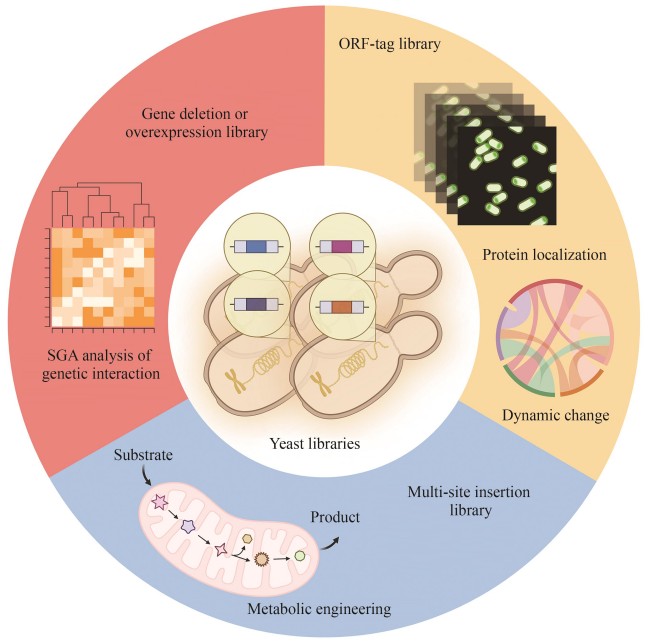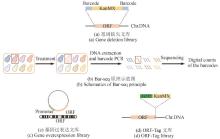|
||
|
Exploration of gene functions and library construction for engineering strains from a synthetic biology perspective
Synthetic Biology Journal
2025, 6 (3):
685-700.
DOI: 10.12211/2096-8280.2024-079
Synthetic biology, as a discipline that designs, constructs, and modifies biological systems to achieve specific functions, is widely applied in biomanufacturing, the biodegradation of environmental pollutants, and drug synthesis. Systematic exploration of gene functions and construction of libraries for engineered strains are driving forces of the development of synthetic biology. These libraries serve as foundational tools for understanding complex biological processes and engineering microorganisms for potential applications. This review focuses on the construction methods and application prospects of various yeast libraries in synthetic biology. With the rapid advancement of genome sequencing and high-throughput screening technologies, microbial libraries, such as those of Saccharomycescerevisiae and Schizosaccharomycespombe, play a pivotal role in systematic research. Yeast libraries, including gene knockout libraries, overexpression libraries, and transposon insertion libraries, provide valuable tools for optimizing gene combinations and designing metabolic pathways, thus promoting applications in metabolic engineering and synthetic biology. These libraries facilitate the development of robust industrial strains, driving improvements in biofuel production, chemical synthesis, and other biotechnological processes. In the environmental field, the screening of modified genes generates strains with pollutant degradation capabilities, contributing to ecological restoration. In drug synthesis, these libraries aid in constructing strains for the efficient production of pharmaceutical compounds, advancing the development of biopharmaceuticals. Despite these successes, there remain challenges in library construction and application, such as the high cost of library generation, difficulty in precise genome editing, and limitation in screening efficiency. In the future, advances in automation, digitization, and novel screening technologies are expected to overcome these barriers, facilitating the rapid construction and efficient screening of yeast libraries. No doubt, synthetic biology holds immense promise, with improvements in library construction and screening processes expected to accelerate the development of sustainable solutions in industrial production, environmental protection, and healthcare, thereby driving innovations in biotechnology.

Fig. 3
Construction of conditional allele libraries (created by biorender)
[(a) In the temperature-sensitive (TS) allele strategy, the ORF (orange fragment) of target gene is replaced with a corresponding TS mutant (dark orange fragment) and tagged with a KanMX resistance marker (yellow fragment). Chr.DNA: chromosomal DNA.(b) In the promoter replacement strategy, an inducible promoter (green fragment) and a KanMX resistance marker (yellow fragment) is inserted upstream of the start codon of the target gene ORF (orange fragment). Chr.DNA: chromosomal DNA.(c) In the DAmP (Decreased Abundance by mRNA Perturbation) strategy, the 3′UTR of the target gene ORF (orange fragment) is disrupted by insertion of a KanR resistance cassette (yellow fragment) to reduce transcript stability and protein abundance. Chr.DNA: chromosomal DNA.]
Extracts from the Article
(1)温度敏感型(temperature sensitive,TS)突变体[28][图3(a)]。该等位基因表达的蛋白在正常或略低的培养温度下正常发挥功能,而在较高温度下因为蛋白折叠问题丧失功能。温度敏感突变等位基因的生成方式包括随机诱变[29-30]、基于蛋白质结构预测技术的理性设计与定向诱变[31-32]、在宿主蛋白内部插入温敏型内含肽[33]等。温度敏感突变体亦可携带分子条形码,便于高通量平行分析,通过“plasmid shuffle”[34]或“diploid shuffle”[30,35]将其整合到宿主中,广泛用于研究必需基因主导的生物过程,如细胞分裂和染色体稳定性[28,30]等。然而,这种方法的缺陷是温度的变化对细胞生理活动的普遍扰动,且已有的必需基因蛋白在温敏条件下仍然可能发挥作用,因此必需基因的功能研究仍不完全。
(2)诱导型启动子替换原生启动子[图3(b)]。例如,使用四环素诱导型启动子TetO7替换原启动子,实验表明,添加足以关闭该基因表达的强力霉素对整体基因表达几乎没有影响[36]。此外,Boone课题组[8]开发并鉴定了β-雌二醇诱导的YETI文库,每个基因的原生启动子被替换成一个工程化后的雌二醇诱导型启动子,每个基因在其原生位点上能够根据不同雌二醇浓度具有不同的表达水平。由于β-雌二醇不是酵母代谢物或信号分子,因此能够极大程度避免细胞代谢受到干扰。不同诱导物浓度与相应启动子的结合能够更加精准地调控基因表达水平,实现类似“变阻器”的效果,更好地研究基因剂量效应。
(3)通过mRNA扰动降低蛋白丰度[37-38](decreased abundance by mRNA perturbation,DAmP)[图3(c)]。此策略通过在必需基因的3′UTR区插入一个抗生素耐药性标记物,降低目标mRNA的稳定性和丰度,使蛋白质水平在天然转录调控下降低,却足以支持菌株生存能力。对于必需基因来说,即便是基因的低水平表达也可以维持细胞的生存,但仍然能表现出一定的生长缺陷或特定的表型,从而揭示该基因的功能。
Other Images/Table from this Article
|


